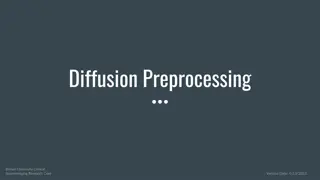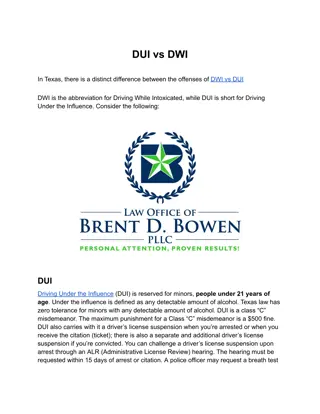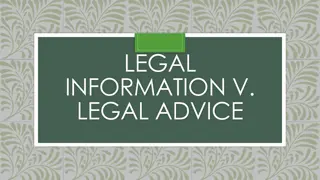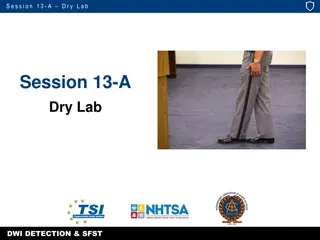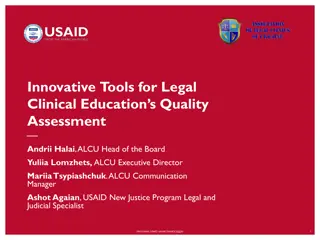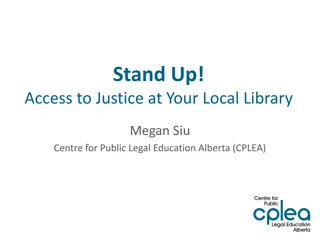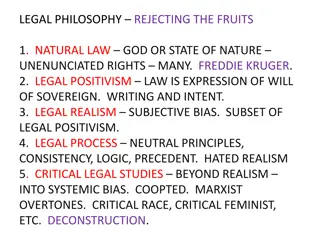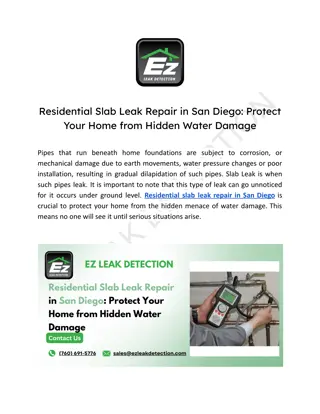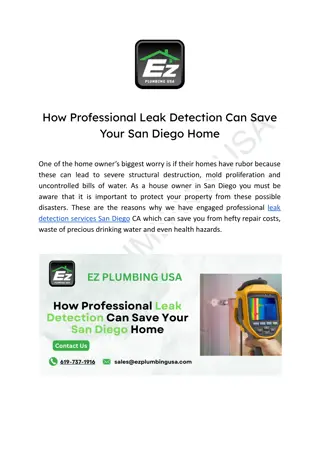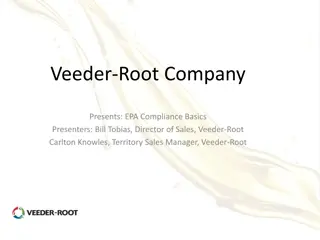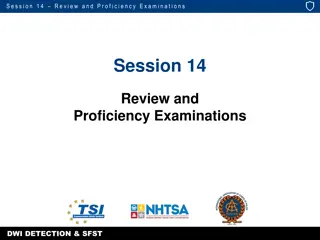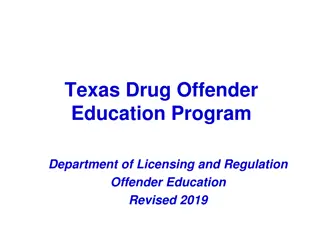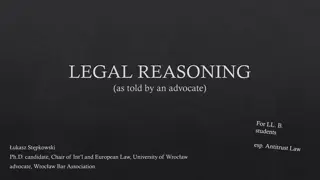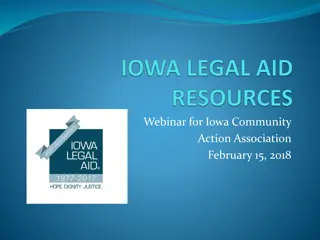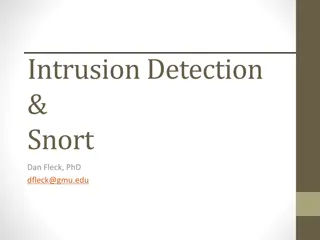Understanding DWI Detection & SFST in the Legal Environment
Explore the legal aspects of DWI detection and Standardized Field Sobriety Testing (SFST) including DUI offenses, implied consent provisions, chemical test evidence, and case law precedents. Delve into the specifics of Tennessee's DUI statute T.C.A. 55-10-401 related to driving under the influence of intoxicants, substances affecting the central nervous system, and alcohol concentration limits. Gain insight into legal definitions such as driving, physical control, vehicle location, and impairment.
Download Presentation

Please find below an Image/Link to download the presentation.
The content on the website is provided AS IS for your information and personal use only. It may not be sold, licensed, or shared on other websites without obtaining consent from the author. Download presentation by click this link. If you encounter any issues during the download, it is possible that the publisher has removed the file from their server.
E N D
Presentation Transcript
S e s s i o n 3 T h e L e g a l E n v i r o n m e n t Session 3 The Legal Environment DWI DETECTION & SFST Revised 3/15/23
S e s s i o n 3 T h e L e g a l E n v i r o n m e n t Learning Objectives Be familiar with: Elements of DUI offenses Provisions of implied consent Relevance of chemical test evidence Precedents established through case law DWI DETECTION & SFST 3 - 2
S e s s i o n 3 T h e L e g a l E n v i r o n m e n t DUI Statute: T.C.A. 55-10-401 DWI DETECTION & SFST 3 - 3
S e s s i o n 3 T h e L e g a l E n v i r o n m e n t T.C.A. 55-10-401 It is unlawful for any person to drive or to be in physical control of any automobile or other motor driven vehicle on any of the public roads and highways of the state, or on any streets or alleys, or while on the premises of any shopping center, trailer park, or apartment house complex, or any other premises that is generally frequented by the public at large, while: DWI DETECTION & SFST 3 - 4
S e s s i o n 3 T h e L e g a l E n v i r o n m e n t T.C.A. 55-10-401 (1) Under the influence of any intoxicant, marijuana, controlled substance, controlled substance analogue, drug, substance affecting the central nervous system, or combination thereof that impairs the driver's ability to safely operate a motor vehicle by depriving the driver of the clearness of mind and control of oneself that the driver would otherwise possess; DWI DETECTION & SFST 3 - 5
S e s s i o n 3 T h e L e g a l E n v i r o n m e n t T.C.A. 55-10-401 (2) The alcohol concentration in the person's blood or breath is eight-hundredths of one percent (0.08%) or more; or (3) With a blood alcohol concentration of four- hundredths of one percent (0.04%) or more and the vehicle is a commercial motor vehicle as defined in 55-50-502. DWI DETECTION & SFST 3 - 6
S e s s i o n 3 T h e L e g a l E n v i r o n m e n t Legal Definitions Driving Physical Control Vehicle Location Impaired/Under the Influence DWI DETECTION & SFST 3 - 7
S e s s i o n 3 T h e L e g a l E n v i r o n m e n t Physical Control State v. Lawrence, 849 S.W.2d 761 (Tenn. 1993). Physical Control within the meaning of T.C.A. 55-10-401 is examined by Totality of Circumstances. Some factors to be considered: 1) The location of the defendant in relation to the vehicle; 2) The whereabouts of the ignition key; 3) Whether the motor vehicle is running; 4)The ability of the defendant, but for his/her intoxication, to direct the use or non-use of the motor vehicle; or 5) The extent to which the vehicle is capable of being operated under its own power or otherwise. DWI DETECTION & SFST 3 - 8
S e s s i o n 3 T h e L e g a l E n v i r o n m e n t Physical Control In Lawrence, TN Supreme Court stated, It is our opinion that the Legislature, in making it a crime to be in physical control of an automobile while under the influence of an intoxicant, intended to enable the drunken driver to be apprehended before he strikes. See Hughes, 535 P.2d 1023,1024 (Okla. 1975). DWI DETECTION & SFST 3 - 9
S e s s i o n 3 T h e L e g a l E n v i r o n m e n t Physical Control State v. Butler, 108 S.W.3d 845 (Tenn. 2003). Defendant located by security guard (off duty officer) 50 feet from entrance to Walmart, 100 yards from his motorcycle after customer advised him that a man was wondering around the parking lot [who] appeared to be intoxicated. Defendant carrying spark plug, spark plug wrench, and admitted to driving to the store. Combination of circumstantial evidence and physical control sufficient to convict. DWI DETECTION & SFST 3 - 1 0
S e s s i o n 3 T h e L e g a l E n v i r o n m e n t Motor Driven Vehicle T.C.A. 55-8-101 contains the definitions applicable to Chapters 8 and 10 of Title 55. YOU MUST READ THROUGH ALL the definitions because an electric scooter, though not considered a motor vehicle in the broad definition, is specifically considered a motor vehicle for the purposes of driving under the influence. DWI DETECTION & SFST 3 - 11
S e s s i o n 3 T h e L e g a l E n v i r o n m e n t Location T.C.A. 55-8-101 includes definitions of highway, roadway, and street, but the word public broadens the definition to include the shoulder for the purposes of a DUI conviction. State v. Mains, 634 S.W.2d 280 (Tenn. Crim. App. 1982). DWI DETECTION & SFST 3 - 1 2
S e s s i o n 3 T h e L e g a l E n v i r o n m e n t Location From the language of the statute, it is obvious that "any of the public roads or highways of the state," "any streets or alleys," "the premises of any shopping center, trailer park, or apartment house complex," and "any other premises that is generally frequented by the public at large" are each separate and distinct locations that are listed by the legislature as places where driving under the influence is prohibited. State v. Van De Gejuchte, 2018 Tenn. Crim. App. LEXIS 834 (Nov. 19, 2018). DWI DETECTION & SFST 3 - 1 3
S e s s i o n 3 T h e L e g a l E n v i r o n m e n t Probable Cause for DUI Arrest Opinion based on totality of circumstances there is probable cause to believe defendant committed crime of Driving Under the Influence All elements of crime need to be present Drive/Physical Control Motor Driven Vehicle Public Road . . . While Under the Influence DWI DETECTION & SFST 3 - 1 4
S e s s i o n 3 T h e L e g a l E n v i r o n m e n t Probable Cause Defined Probable cause exists when at the time of the arrest, the facts and circumstances within the knowledge of the officers, and of which they have reasonably trustworthy information, are sufficient to warrant a prudent person in believing that the defendant had committed or was committing an offense. State v. Echols, 382 S.W.3d 266 (Tenn. 2012). DWI DETECTION & SFST 3 - 1 5
S e s s i o n 3 T h e L e g a l E n v i r o n m e n t Probable Cause State v Bell, 429 S.W.3d 524 (Tenn. 2014) The supreme court held that the officer had probable cause to arrest the defendant for DUI without a warrant. Performance on field sobriety tests is only one, of the many factors, officers should consider when deciding whether to arrest a motorist for DUI or similar offenses without a warrant. Mr. Bell did well on the SFSTs, but he exhibited bad driving, smelled of alcohol and admitted to drinking alcohol. His BAC was .15% DWI DETECTION & SFST 8 - 1 6
S e s s i o n 3 T h e L e g a l E n v i r o n m e n t Probable Cause Found State v. Reynolds, 504 S.W.3d 283 (Tenn. 2016). The determination of probable cause involves an objective assessment of the facts and circumstances within the knowledge of the officers. The totality of the facts and circumstances including the defendant's admission to drinking and driving, the odor of alcohol on and about her person, and her poor performance on the HGN test were sufficient to warrant a prudent officer in believing that the defendant was driving under the influence of an intoxicant when the accident occurred. DWI DETECTION & SFST 3 - 1 7
S e s s i o n 3 T h e L e g a l E n v i r o n m e n t Conviction Criminal offense establish facts beyond a reasonable doubt DWI DETECTION & SFST 3 - 1 8
S e s s i o n 3 T h e L e g a l E n v i r o n m e n t Beyond a Reasonable Doubt The state has the burden of proving the guilt of the defendant beyond a reasonable doubt, and this burden never shifts but remains on the state throughout the trial of the case. The defendant is not required to prove [his] [her] innocence. T.P. I. Criminal 2.02 DWI DETECTION & SFST 3 - 1 9
S e s s i o n 3 T h e L e g a l E n v i r o n m e n t Reasonable Doubt Defined Reasonable doubt is that doubt created by an investigation of all the proof in the case and an inability, after such investigation, to let the mind rest easily as to the certainty of guilt. Absolute certainty of guilt is not demanded by the law to convict of any criminal charge, but moral certainty is required, and this certainty is required as to every element of proof necessary to constitute the offense. T.P.I. Criminal 2.03 DWI DETECTION & SFST 3 - 2 0
S e s s i o n 3 T h e L e g a l E n v i r o n m e n t For Conviction All elements of the offense must be established and proven beyond a reasonable doubt. Therefore, it is important to collect and thoroughly document the evidence. DWI DETECTION & SFST 3 - 2 1
S e s s i o n 3 T h e L e g a l E n v i r o n m e n t Per Se Statute T.C.A. 55-10-401 (Non-Commercial Vehicle) (1) DUI (2) The alcohol concentration in the person's blood or breath is eight-hundredths of one percent (0.08%) or more; (impairment is not required for Per Se) DWI DETECTION & SFST 3 - 2 2
S e s s i o n 3 T h e L e g a l E n v i r o n m e n t Per Se Statute T.C.A. 55-10-401 (Commercial Vehicle) (1) DUI (3) With a blood alcohol concentration of four-hundredths of one percent (0.04%) or more and the vehicle is a commercial motor vehicle as defined in 55-50-502. (impairment is not required for Per Se) DWI DETECTION & SFST 3 - 2 3
S e s s i o n 3 T h e L e g a l E n v i r o n m e n t DUI and DUI Per Se DUI driving under influence Chemical test is additional evidence DUI Per Se driving while having more than a statutorily prohibited BAC Chemical test is presumptive evidence DWI DETECTION & SFST 3 - 2 4
S e s s i o n 3 T h e L e g a l E n v i r o n m e n t Per Se Purpose Aids in Prosecuting DUI Offenders Shows Jurors that Offender s BAC was At or Above Statutory Limit. Raises an Inference of Guilt. Often Required to Secure a Conviction. DWI DETECTION & SFST 3 - 2 5
S e s s i o n 3 T h e L e g a l E n v i r o n m e n t Per Se Summary Continue to rely on your detection training and experience. Assume chemical tests will not be available. Thorough documentation is critical. DWI DETECTION & SFST 3 - 2 6
S e s s i o n 3 T h e L e g a l E n v i r o n m e n t Implied Consent Law T.C.A. 55-10-406 DWI DETECTION & SFST 3 - 2 7
S e s s i o n 3 T h e L e g a l E n v i r o n m e n t Elements Of Implied Consent Operates or controls motor vehicle Operator deemed to have given consent to chemical testing Arrested for DUI Drivers who refuse are subject to license sanctions (loss of driving privileges and ignition interlock requirements). DWI DETECTION & SFST 3 - 2 8
S e s s i o n 3 T h e L e g a l E n v i r o n m e n t Implied Consent (a) A law enforcement officer who has probable cause to believe that the operator of a motor vehicle is driving while under the influence of any intoxicant, controlled substance, controlled substance analogue, drug, substance affecting the central nervous system, or combination thereof as prohibited by 55-10-401, or committing the offense of vehicular assault under 39-13-106, aggravated vehicular assault under 39-13-115, vehicular homicide under 39-13-213(a)(2), or aggravated vehicular homicide under 39-13-218, may request that the operator of the vehicle submit to test or tests for the purpose of determining the alcohol or drug content, or both, of that operator's blood. DWI DETECTION & SFST 3 - 2 9
S e s s i o n 3 T h e L e g a l E n v i r o n m e n t Breath Consent Search Warrant Incident to Arrest Exigent Circumstances DWI DETECTION & SFST 3 - 3 0
S e s s i o n 3 T h e L e g a l E n v i r o n m e n t Blood Consent Search Warrant Exigent Circumstances DWI DETECTION & SFST 3 - 3 1
S e s s i o n 3 T h e L e g a l E n v i r o n m e n t Blood or Breath-Decision A law enforcement officer administering breath or blood tests shall decide whether to administer or cause to be administered breath tests, blood tests, or both tests, for determining the alcohol or drug content of the operator's blood. DWI DETECTION & SFST 3 - 3 2
S e s s i o n 3 T h e L e g a l E n v i r o n m e n t (c)(2)(A)-Test Required Crash involvement with DUI or greater DUI related offense involving injury or death Committed DUI or greater related offense and minor in vehicle, or Committed DUI or greater related offense with prior convictions for DUI or greater related offense in history DWI DETECTION & SFST 3 - 3 3
S e s s i o n 3 T h e L e g a l E n v i r o n m e n t Use in Evidence The results of breath or blood tests required by subdivision (c)(2)(A) may be offered as evidence by either the state or the operator of the vehicle in any court, administrative hearing, or official proceeding relating to the collision or offense, subject to the Tennessee Rules of Evidence. DWI DETECTION & SFST 3 - 3 4
S e s s i o n 3 T h e L e g a l E n v i r o n m e n t Implied Consent (d)(1)The operator of a motor vehicle in this state is deemed to have given implied consent to breath tests, blood tests, or both tests, for the purpose of determining the alcohol or drug content of that operator's blood. However, no such tests may be administered pursuant to this section unless conducted at the direction of a law enforcement officer having probable cause to believe the operator was in violation of one (1) or more of the offenses set out in subsection (a) and the operator signs a standardized waiver developed by the department of safety and made available to law enforcement agencies. DWI DETECTION & SFST 3 - 3 5
S e s s i o n 3 T h e L e g a l E n v i r o n m e n t Inferences BAC of 0.08% or more Evidence from the test that there was, at the time alleged, eight-hundredths of one percent (.08%) or more by weight of alcohol in the defendant's blood, creates an inference that the defendant was under the influence of such intoxicant, and that the defendant's ability to drive was impaired. Excerpt from T.P.I. Criminal 38.05 DWI DETECTION & SFST 3 - 3 6
S e s s i o n 3 T h e L e g a l E n v i r o n m e n t Refusal of Test as Evidence If you find from the proof that the defendant was offered and refused to submit to a test for the purpose of determining the alcohol or drug content of [his] [her] blood and that the law enforcement officer advised the defendant that refusal to submit to such a test will result in suspension of [his] [her] operator's license, then such refusal is not sufficient standing alone and by itself to establish the guilt of the defendant, but it is a fact which, if proved, may be considered by you in the light of all other proved facts in deciding whether the defendant is guilty or not guilty. The weight to which such a circumstance is entitled and whether or not such conduct shows a consciousness of guilt are matters for your determination. T.P.I. Criminal 38.04 DWI DETECTION & SFST 3 - 3 7
S e s s i o n 3 T h e L e g a l E n v i r o n m e n t Example Number 1 Driver arrested for DUI BAC of 0.13 Chemical test evidence introduced at trial Arresting officer s testimony was confusing and unclear State unable to prove all elements beyond a reasonable doubt DWI DETECTION & SFST 3 - 3 8
S e s s i o n 3 T h e L e g a l E n v i r o n m e n t Example Number 2 Driver arrested for DUI BAC of 0.05 Chemical test evidence introduced at trial Arresting officer s testimony is clear and descriptive Court finds defendant guilty of DUI DWI DETECTION & SFST 3 - 3 9
S e s s i o n 3 T h e L e g a l E n v i r o n m e n t Preliminary Breath Testing (PBT) Not admissible at trial to prove impairment in Tennessee. Can be used for: Underage Consumption Courtroom Sobriety DRE-Alcohol Rule Out Basis for Probable Cause DWI DETECTION & SFST 3 - 4 0
S e s s i o n 3 T h e L e g a l E n v i r o n m e n t Case Law Reviews Landmark court decisions relevant to admissibility of SFSTs Challenges may be based on: Scientific validity and reliability Relationship of HGN to specific BAC level Officer training, experience, and application DWI DETECTION & SFST 3 - 4 1
S e s s i o n 3 T h e L e g a l E n v i r o n m e n t SFST Case Law DWI DETECTION & SFST 3 - 4 2
S e s s i o n 3 T h e L e g a l E n v i r o n m e n t SFSTs are Relevant State v. Hodges, No. M2008-00776-CCA-R3-CD, 2009 Tenn. Crim. App. LEXIS 772 (Tenn. Crim. App., Sept. 17, 2009), app l denied, 2010 Tenn. LEXIS(Tenn., Mar. 22, 2010). Because a driver's objective manifestations of intoxication are always relevant in a driving under the influence prosecution, . . . field sobriety tests are admissible. DWI DETECTION & SFST 3 - 4 3
S e s s i o n 3 T h e L e g a l E n v i r o n m e n t Horizontal Gaze Nystagmus Case Law DWI DETECTION & SFST 3 - 4 4
S e s s i o n 3 T h e L e g a l E n v i r o n m e n t HGN State v. Murphy, 953 S.W.2d 200 (Tenn. 1997). The average juror would not know, as a matter of course, that a correlation exists between alcohol consumption and nystagmus. Consequently, testimony concerning the HGN field sobriety test constitutes scientific, technical, or other specialized knowledge. AS such, it must be offered through an expert witness and must meet the requirements of Tenn. R. Evid. 702 and 703 as explained in McDaniel v. CSX Transportation, 955 S.W.2d 257, (Tenn. 1997). DWI DETECTION & SFST 3 - 4 5
S e s s i o n 3 T h e L e g a l E n v i r o n m e n t HGN State v. Murphy Witness must explain underlying scientific basis of test for testimony to be meaningful to jury. Witness must be qualified as an expert based upon their knowledge, skill, experience, training and education. HGN must be performed properly with correct timings and distances. DWI DETECTION & SFST 3 - 4 6
S e s s i o n 3 T h e L e g a l E n v i r o n m e n t HGN State v. Murphy In determining the reliability of scientific evidence, the court will consider: 1) Has the scientific evidence ever been tested and with what methodology; 2) Has it been subjected to peer review; 3) Is the potential rate of error known; 4) Is it generally accepted in the scientific community; and 5) Has the research been independent of litigation DWI DETECTION & SFST 3 - 4 7
S e s s i o n 3 T h e L e g a l E n v i r o n m e n t Search and Seizure Case Law Interpretations using the Fourth Amendment and Article I, Section 7 DWI DETECTION & SFST 3 - 4 8
S e s s i o n 3 T h e L e g a l E n v i r o n m e n t Is the Person Seized? State v. Williams, 185 S.W.3d 311 (Tenn. 2006). In determining whether an officer's conduct amounted to a seizure under the Fourth Amendment and Article I, Section 7, the court will consider "all the circumstances surrounding the encounter to determine whether police conduct would have communicated to a reasonable person that the person was not free to decline the officer's request or otherwise terminate the encounter." DWI DETECTION & SFST 3 - 4 9
S e s s i o n 3 T h e L e g a l E n v i r o n m e n t Seizure State v. Pulley, 863 S.W.2d 29 (Tenn. 1993) The defendant was seized when the officer activated his blue lights Objective test Officer must have reasonable suspicion or probable cause to initiate blue lights Exceptions are rare (911, Community Caretaking) DWI DETECTION & SFST 8 - 5 0


